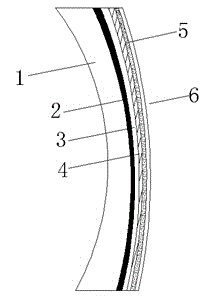Anti-fog lens with dopamine as surface bonding layer, and technological process thereof
A technology of surface bonding and dopamine, which is applied in the application field of anti-fog glasses lens production, can solve the problems of inability to realize anti-fog function and inability to add anti-fog function to glasses, and achieve the effect of strong practicability, novelty and firm adhesion
- Summary
- Abstract
- Description
- Claims
- Application Information
AI Technical Summary
Problems solved by technology
Method used
Image
Examples
Embodiment Construction
[0020] From figure 1 Known, the present invention adopts dopamine as the anti-fog lens made of resin lens surface bonding layer, successively by resin substrate 1, adds dura mater layer 2, anti-reflection film layer 3, waterproof film layer 4, dopamine bonding layer 5, The anti-fog film layer 6 is composed of a dopamine adhesive layer 5 dipped on the surface of the waterproof film layer 4 , and a hydrophilic anti-fog film layer 6 is dip-coated and bonded on the surface of the dopamine adhesive layer 5 . The resin lens substrate 1 is a resin lens with a refractive index of 1.499, 1.56, 1.60, 1.67, 1.71, 1.74, 1.76, and the substrate monomer material is allyl diglycol carbonate, dipropylene isophthalate , a kind of amino resin. The hard coating layer 2 adopts silicon dioxide hardening liquid or TS-56-T resin lens hardening liquid. The anti-reflection film 3 is an anti-reflection film layer evaporated under vacuum conditions using zirconia and magnesium oxide materials using a ...
PUM
 Login to View More
Login to View More Abstract
Description
Claims
Application Information
 Login to View More
Login to View More - R&D
- Intellectual Property
- Life Sciences
- Materials
- Tech Scout
- Unparalleled Data Quality
- Higher Quality Content
- 60% Fewer Hallucinations
Browse by: Latest US Patents, China's latest patents, Technical Efficacy Thesaurus, Application Domain, Technology Topic, Popular Technical Reports.
© 2025 PatSnap. All rights reserved.Legal|Privacy policy|Modern Slavery Act Transparency Statement|Sitemap|About US| Contact US: help@patsnap.com


